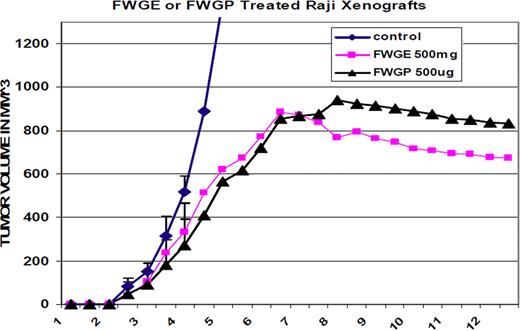Abstract
Abstract 2857
Non-Hodgkin's lymphoma (NHL) affects over 400,000 people in the United States and its incidence increases with age. Treatment options include cytotoxic chemotherapy, which is often poorly tolerated by elderly patients, and monoclonal antibody (mAb) therapy. Nearly 70% of NHL patients eventually die of the disease. Development of effective alternate treatments with favorable toxicity profiles is necessary. Fermented wheat germ extract (FWGE) has shown anticancer potential in laboratory animals as well as in some small clinical studies; it is produced under GMP conditions in Europe and sold as Avemar™. The mechanism of action of FWGE is unclear, but is thought to involve metabolic pathways involved in tumor cell death. We examined the effects of FWGE on NHL and found significant lymphomacidal activity using in vitro and in vivo assays. We then further purified and characterized the active components of FWGE in order to develop a more potent form and to understand the mechanism of action, physiologic, and immunologic properties.
FWGE was produced by fermenting purified wheat germ (Triticum aestivum) with Baker's yeast. The FWGE was further purified by removing insoluble material, precipitating proteins, freeze drying, fractionating with Sepharose and Sephadex columns, and then dialyzing to remove small molecules. The resultant fermented wheat germ proteins (FWGP) were assessed for in vitro cytotoxicity and pro-apoptotic activity using a panel of NHL cell lines. In vivo lymphomacidal activity was assessed in nude mice bearing Raji lymphoma xenografts. Mice were treated with increasing daily doses of FWGE by gastric lavage and compared to untreated controls as well as the commercially available fermented wheat germ product, Avemar.
In vitro killing assays with FWGE (regardless of the source) demonstrated lymphomacidal properties in three NHL cell lines (Jurkat, Raji, and Ramos). Pre-treatment of FWGE with heat or proteinase K reduced the lymphomacidal activity, suggesting that the active component was a protein. Nude mice bearing Raji lymphoma xenografts treated with FWGE confirmed the lymphomacidal properties of FGWE; there was no detectable toxicity as assessed by observation, mouse weight, or blood counts. The purified low molecular weight proteins (FWGP) also demonstrated lymphomacidal properties by cytotoxicity assays and murine NHL models, but at 1/1000th of the original dose. When FWGP was combined with rituximab, there was enhanced in vitro lymphomacidal activity, with over a 4000-fold reduction in the IC50. FWGP-induced NHL cell death was mediated by caspase-3-dependent apoptosis. FWGP augmented the host immune effector mechanisms, including ADCC and CDC, along with potent activation of NK-T cells (CD3/69/16), CD4+ T-cells and monocytes.
FWGE can be easily produced and has cytotoxic effects in in vitro assays and in vivo. The purified FWGP are quantifiable, and are 10–1000 times more potent than FWGE. The mechanism of FWGP activity is based on direct pro-apoptotic effects as well as augmentation of host immune mediators. FWGP has activity against various subtypes of NHL. Studies are ongoing to further characterize the immune effects and anti-cancer properties of FWGP, as is planning for a human clinical trial +/− rituximab in patients with NHL.
No relevant conflicts of interest to declare.
Author notes
Asterisk with author names denotes non-ASH members.



This feature is available to Subscribers Only
Sign In or Create an Account Close Modal